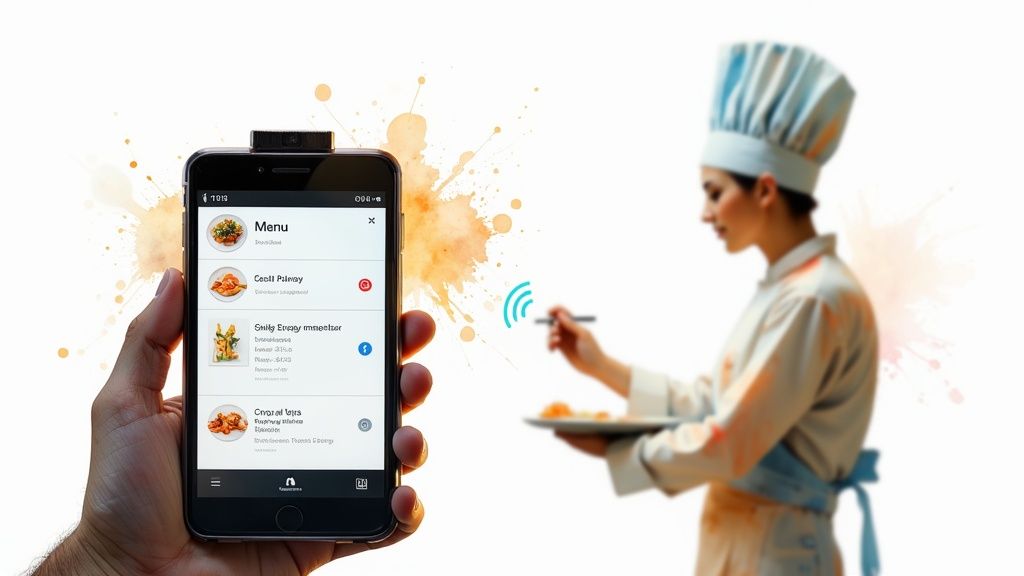How a handheld POS can boost efficiency and increase sales. Essential features, benefits, and tips.

A handheld POS is a device that puts your entire point-of-sale terminal in your server's hands. Instead of running to a stationary POS terminal, your staff can take orders, process payments, and send tickets to the kitchen from anywhere on the floor. It’s about speeding up service and improving order accuracy, especially during a chaotic dinner rush.
A handheld POS creates a live connection between your servers, the kitchen, and the bar, cutting the extra steps that cost time on every order. A server can fire off an appetizer and drink order before they leave the table, instead of scribbling it down and waiting in line at a terminal. That order pops up instantly on the kitchen display system (KDS), getting production started minutes sooner.
This solves common service headaches that impact your bottom line.
The handheld POS market is projected to grow from USD 33.15 billion in 2025 to USD 89.52 billion by 2035, with restaurants making up about 18% of this market. This shows how critical these tools are for staying competitive. You can see the full handheld POS market research for more details.
A handheld POS directly impacts your bottom line by turning tables faster and protecting your margins. The biggest win is speed. When a server can punch in an order and swipe a card without leaving the table, you eliminate wasted steps.
Shaving just 15 minutes off the average table time during a busy rush can add up. For a 20-table restaurant, turning each table one more time per night could mean thousands in extra revenue each month. By removing the payment bottleneck, servers clear and reset tables faster, seating more guests during your most valuable hours.
Messy handwriting on a ticket leads to kitchen chaos, wasted food, and comped meals that eat into your profit margins. With a handheld restaurant POS, every order is digital and clear.
A less chaotic shift allows your team to focus on genuine hospitality, which means better guest interactions and bigger tips. When you give servers the right tools, they feel more in control and less likely to burn out. They have more time to answer menu questions, suggest upsells, and provide service that turns first-time visitors into regulars. For more ideas, see our guide on maximizing your business with mobile POS solutions.

Not all handheld systems can survive a Saturday night. Many are generic payment terminals that will fail you when you need them most.
Focus on restaurant-specific features that make a difference on the floor.
The device itself is your front line. It must be tough, reliable, and ready for a long shift.
The software determines how smoothly your service flows. The best handheld POS for restaurants anticipates problems like a spotty internet connection and provides a solution.
The right handheld POS should match your service style, not force you to change your workflow.
In QSRs, the top priority is speed. Your handheld POS needs:
For full-service restaurants, the focus shifts to precision and guest experience. Look for:
Bars need to manage high volumes of tabs during a rush. A handheld lets servers manage their own tabs, freeing up the bartender to make drinks.
Launching a handheld POS system doesn't have to be a disaster. With a solid plan, the switch can be seamless for your team and invisible to guests. Success is all about preparation.
Getting these details right will save you from headaches during a slammed shift.
Hardware is just as critical as software. For a deep dive, our essential POS hardware checklist for new restaurants has you covered.
Your team's confidence is everything. Ditch the manuals and focus on hands-on practice. The best way to train is to role-play. Have servers practice taking complex orders and splitting checks in a test mode to build muscle memory.
Start small. Roll out a few devices during a slow shift, like a Tuesday lunch. This creates a low-stakes environment for learning. Once your team is comfortable, you can gradually add more devices.
Here are straight answers to the questions we hear most from restaurant owners.
It varies. Look at the total cost of ownership, not just the hardware price. Some companies offer "free" hardware but lock you into high payment processing fees. Others charge upfront for devices—$300 to over $1,000 each—plus a monthly software subscription per terminal.
To compare accurately, map out the complete cost: hardware + monthly software fees + payment processing rate. Always demand a clear breakdown of all costs. A quality handheld POS pays for itself by turning more tables and cutting costly mistakes.
This is why a robust offline mode is a non-negotiable feature. A reliable offline mode lets your servers keep taking orders. The handheld stores order data locally and sends tickets to kitchen printers over your internal network, even when the internet is out.
When vetting systems, ask for a demo of their offline mode. A system that becomes a paperweight when your Wi-Fi flickers is a liability.
Modern handheld POS systems are designed to be as intuitive as a smartphone. Most staff can learn the basics in under an hour. A clean, simple user interface is key.
A smart training plan is about hands-on practice:
The best systems require the least training, so your team can focus on hospitality, not technology.
Your handheld POS must work with your other critical systems. Before signing a contract, make a checklist of your current tech:
Confirm with any POS provider that their handhelds will integrate seamlessly.
Ready to see how a system designed by restaurant people can solve these challenges?
Peppr was built to handle the realities of your floor. Book a demo today and see how our handheld POS can make your service smoother.
